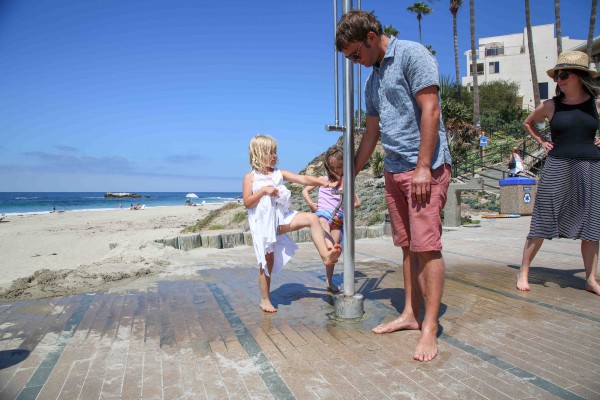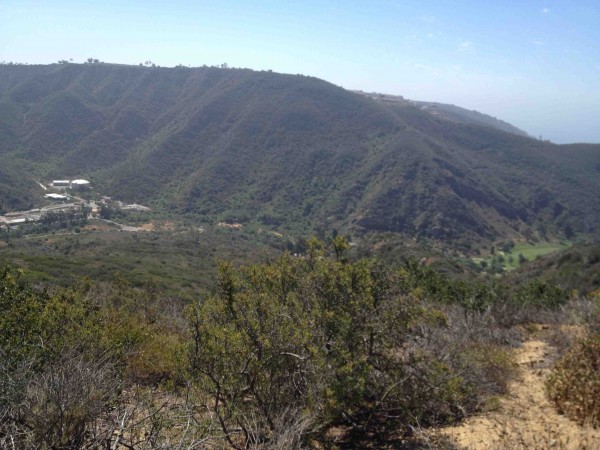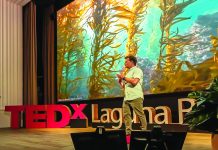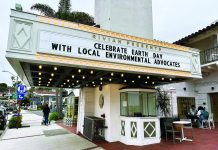
Photo by Jody Tiongco
With residents hauling buckets to their yards with water captured in warming showers and state parks and beaches this week turning off their outdoor showers, the City Council Tuesday approved more citywide water conservation measures, including a temporary moratorium on new pool construction.
For the first time, they also promoted graywater systems that irrigate landscaping with shower and laundry runoff, agreeing to waive any fees associated with the installation process.
“All of these are fine,” said Mayor Bob Whalen, but ultimately Laguna must pursue a long-term solution to address its water needs involving reclaimed and treated water, he said, expressing a sentiment shared by Council members and public commenters alike.
In response to a statewide mandate to cut water use by 25 percent, both water districts serving Laguna’s residents have already imposed landscape watering and other restrictions. In a July 1 mailer, the Laguna Beach County Water District called on customers to reduce their daily water use by 29 gallons in order to meet their target.
With the residents already doing their part, the Council approved further measures Tuesday. These included policies bypassing design review approvals for homeowners when swapping landscaping for drought tolerant options and favoring low-water plantings in city park renovations. New rules are also in the works to require pool covers to prevent evaporation and ban water features unless they use recycled water.
Alan Boinus pointed out the problems of the city’s “bifurcated” water districts, where residents south of Nyes Place answer to stricter regulations than the rest of the city.
“It is important to me that we have consistency between what the water districts are doing,” agreed Mayor Pro Tem Steve Dicterow, who said the Laguna Beach County Water District, which serves most of the city and relies exclusively on imported water, should align their restrictions more closely with those of South Coast Water District, which serves South Laguna and other cities. Most of its water is also imported, but the district also reclaims water from its Aliso Creek treatment plant.
Dicterow also called for a plan to capture storm runoff if an anticipated El Nino season arrives.
Council member Toni Iseman called for a moratorium on new pool construction and asked staff to educate the public on using graywater to irrigate water-shriveled plants.
Graywater can be safely redirected from bathtubs, showers, bathroom (but not kitchen) sinks and laundries if residents follow the proper guidelines, said Dennis Bogle, a city building official.
According to a fact sheet on the city web site, installation of simple systems, involving either a clothes washer or a single plumbing fixture, only require filing a notice with the city, while more complex systems require a permit. Even so, guidelines advise against using graywater to irrigate fruit trees or vegetable gardens.
Residents need to avoid allowing graywater runoff or oversaturating and potentially destabilizing hillsides, cautioned City Manager John Pietig. Such water-diversion systems have benefits but “need to be done right,” he said.
Resident Charlotte Masarik urged installation of smart water meters, which would allow residents to monitor their consumption in real time. The Laguna Beach County Water District has budgeted to install smart meters next year, said Council member Rob Zur Schmiede, suggesting that hotels and restaurants should also install more water saving fixtures and waterless urinals.
Just as the recent fire in the canyon galvanized consensus around the urgency of undergrounding utilities, this drought should be treated as a similar emergency, said resident Billy Fried, calling for new city infrastructure to tap into reclaimed water.
Mike Beanan, of the South Laguna Civic Association, asked the Council to consider building a water distribution system to carry reclaimed water from Aliso Creek to irrigate public spaces north of Nyes Place. He outlined a possible pipeline route.
“I don’t get the sense that we are pooling our resources and really trying to come up with some innovative ideas,” such as Beanan’s proposal, said Zur Schmiede.

He called for the city officials to convene with the two water districts, South Orange County Wastewater Authority, which treats wastewater for 10 member agencies, and others to jointly pursue new water sources.
Zur Schmiede said he came away impressed after touring a pilot desalination plant and Orange County Water District’s wastewater recycling plant. There, he drank two glasses of the recycled water. “And I’m here to tell the tale,” he said, dispelling the fears people often express about so-called toilet to tap recycling.
Whalen suggested directing the city’s Sacramento lobbyist to push for a revision in rules that currently prohibit adding treated water directly to water distribution systems. Currently, recycled wastewater must first be integrated into an existing water source, such as a groundwater basin, before being piped into homes.
Whalen also put more weight behind a previous request that the two water districts develop a project to take advantage of $1 billion that the governor budgeted for water projects this year.
Iseman suggested potentially hiring a consultant to identify the kind of “shovel ready” project most likely to win grants.
Ultimately, the Council unanimously passed a variety of conservation measures, adopted a policy to maximize water recapture and recycling efforts, and approved identifying a project to submit for state grant money.
“I’m pretty happy with what we’re going to do here,” said Council member Kelly Boyd, who also praised residents for their conservation efforts. “We are hitting our goals, so the people in this town are really working hard,” he said.
He cautioned that lower water use conversely may result in higher user costs as the districts’ operating costs have not shrunk even though their revenue has.





Be sure to get all of the facts. Water reuse is more dangerous than the risk assessments lead us to believe. http://alzheimerdisease.tv/alzheimers-disease-epidemic-fueled-by-sewage-mismanagement/
Laguna Beach has an abundance of wasted wastewater. We can achieve full water sustainability only when the community demands action to implement modern recycled water technologies. Every South County city recycles much of it’s sewage water. Laguna Beach recycles 0% of wastewater as 10 million gallons of secondary sewage water is discharged just 1.2 miles offshore. Don’t take “can’t do” from City leaders. Demand action now before the next Laguna wildfire.
[…] making any changes to the city code. Such changes were discussed as part of water conservation measures to comply with the state mandate to reduce use by 25 percent. They did get plenty of information, […]